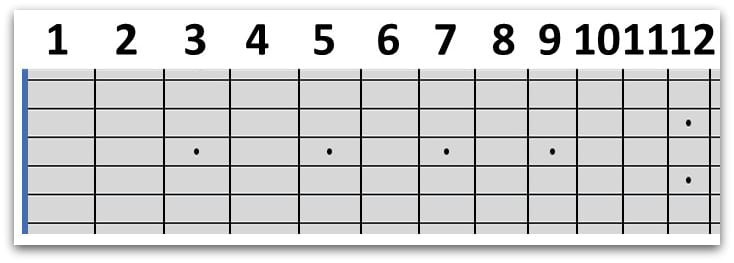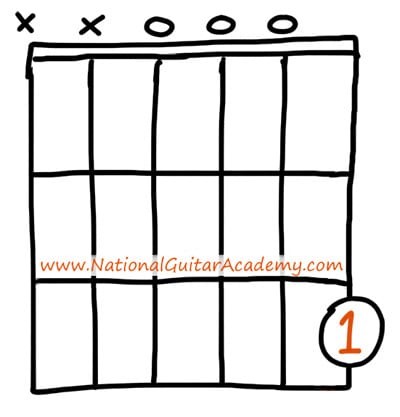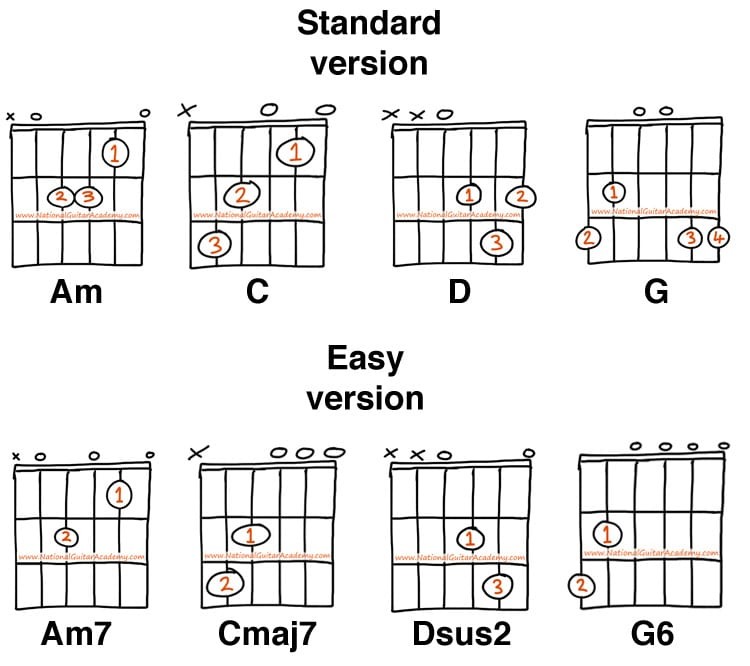Can You Learn Guitar In A Month? Absolutely! At LEARNS.EDU.VN, we believe that with the right approach and dedicated practice, significant progress is achievable in a short time. This guide will equip you with the knowledge and strategies to start your guitar journey successfully. Dive into the world of guitar playing, learn essential skills, and discover how to make rapid progress with our structured approach.
1. Understanding the Fundamentals of Guitar Playing
Before diving into chords and strumming, let’s lay the groundwork by understanding the anatomy of the guitar and its basic functions.
1.1 Knowing Your Instrument
Familiarizing yourself with the parts of the guitar is crucial for effective learning.
| Part of the Guitar | Function |
|---|---|
| Headstock | Contains the tuning pegs used to adjust the pitch of the strings. |
| Tuning Pegs | Adjust the tension of the strings to tune the guitar. |
| Nut | Supports the strings as they pass from the headstock to the fretboard. |
| Neck | Connects the headstock to the body and supports the fretboard. |
| Fretboard | The surface where you press down the strings to change the pitch. |
| Frets | Metal strips that divide the fretboard into specific notes. |
| Sound Hole | The opening in the body of the guitar that allows sound to resonate. |
| Body | The main part of the guitar that amplifies the sound of the strings. |
| Bridge | Attaches the strings to the body of the guitar. |
| Saddle | Supports the strings on the bridge. |
| Strings | Vibrating elements that produce sound when plucked or strummed. |




1.2 Mastering String Names and Notes
Understanding the names of the strings and the notes they produce is fundamental. The guitar has six strings, each tuned to a specific note:
- Low E string: The thickest string, closest to the ceiling when holding the guitar, tuned to E.
- A string: Tuned to A.
- D string: Tuned to D.
- G string: Tuned to G.
- B string: Tuned to B.
- High E string: The thinnest string, closest to the floor, tuned to E.
1.3 The Importance of Tuning
Playing an in-tune guitar is essential. An out-of-tune instrument will sound unpleasant, regardless of your skill level.
- To raise the pitch: Turn the tuning peg away from you.
- To lower the pitch: Turn the tuning peg towards you.
To learn more about tuning your guitar effectively, visit LEARNS.EDU.VN for detailed guides and tutorials.
1.4 Navigating the Fretboard
The fretboard is where you place your fingers to create different notes and chords. Each fret represents a semitone. The frets are numbered, typically from 1 to 20 or more, depending on the guitar.
The “zero” fret refers to playing a string without pressing down on any fret, also known as an open string.
For a comprehensive understanding of guitar notes, LEARNS.EDU.VN offers resources that delve into the intricacies of the fretboard and note placement.
1.5 Utilizing the Sound Hole
The sound hole is where the sound of the guitar resonates. Strumming over the sound hole maximizes resonance and creates a full-bodied sound.
2. Learning Basic Guitar Chords
Chords are the foundation of most guitar music. Learning to play basic chords is a vital step in your guitar journey.
2.1 Understanding Chords
A chord is a combination of notes played simultaneously. Start with simple chords that require only a few fingers.
2.2 Essential Tips for Playing Chords
- Thumb Position: Keep your thumb in the middle of the guitar neck to apply pressure effectively.
- Finger Tips: Use your finger tips to press down on the strings, avoiding contact with other strings.
- Nail Length: Keep your nails short to ensure you can press down on the strings properly.
- Finger Pressure: Ensure your fingers and thumb work together to apply enough pressure for a clear sound.
- Note Clarity: Each note in the chord should ring clearly without any buzzing.
- Fret Placement: Press down on the strings between the fret markers, not directly on them.
2.3 Reading Guitar Chord Boxes
Chord boxes provide a visual representation of where to place your fingers on the fretboard to form a chord.
- X: Indicates a string that should not be played.
- O: Indicates an open string that should be played.
- Vertical Lines: Represent the guitar strings (E, A, D, G, B, E from left to right).
- Horizontal Lines: Represent the frets.
- Circles: Show where to place your fingers.
- Numbers Inside Circles: Indicate which finger to use (1=index, 2=middle, 3=ring, 4=pinky).
For a more detailed explanation of chord boxes, LEARNS.EDU.VN provides comprehensive guides to help you master this essential skill.
2.4 Starting with Stepping Stone Chords
Begin with simplified versions of chords, known as “stepping stone” chords. These require fewer fingers and less dexterity, making them easier to learn.
2.5 Examples of Easy Chords
| Chord | Finger Placement | Strings to Play |
|---|---|---|
| E minor | 2nd fret, A string (2nd finger) | All |
| C major | 1st fret, B string (1st finger) | A, D, G, B, E |
| G major | 2nd fret, A string (1st finger) and 3rd fret, low E string(2nd finger)and 3rd fret, B string(3rd finger) | All |
| D major | 2nd fret, G string (1st finger) | D, G, B, E |
Learning these stepping stone chords is a crucial part of learning guitar quickly. As you progress, you can move on to more complex versions of these chords.
3. Mastering Strumming and Rhythm
Rhythm is as important as chords. Developing a good sense of rhythm and mastering strumming techniques will significantly enhance your guitar playing.
3.1 Basic Strumming Techniques
- Elbow Movement: Generate the strumming motion primarily from your elbow, with minimal wrist movement.
- Wrist Position: Keep your wrist straight and relaxed.
3.2 Tips for Maintaining Rhythm
- Use a Metronome: Practice with a metronome to develop a consistent sense of timing.
- Tap Your Foot: Tap your foot along with the beat to internalize the rhythm.
- Count Out Loud: Count the beats out loud to stay on track.
- Record Yourself: Recording yourself playing can help you identify areas where your rhythm is inconsistent.
3.3 Common Strumming Patterns
- Down, Down, Down, Down: A simple and basic pattern.
- Down, Up, Down, Up: Adds a bit more complexity.
- Down, Down, Up, Down, Up: A popular and versatile pattern.
3.4 Practicing with Songs
Choose simple songs with basic chord progressions to practice your strumming and rhythm. Start slowly and gradually increase the tempo as you become more comfortable.
3.5 Strumming Exercises
| Exercise | Description |
|---|---|
| Single Chord Strumming | Practice strumming a single chord repeatedly, focusing on maintaining a consistent rhythm. |
| Chord Change Strumming | Practice switching between two chords while maintaining a steady strumming pattern. |
| Muted Strumming | Mute the strings with your fretting hand while strumming to focus on rhythm and timing without worrying about chords. |
| Varying Strumming Speed | Practice strumming at different speeds to improve your control and adaptability. |
4. Setting Up Your Practice Routine
Consistency is key to learning guitar in a month. A well-structured practice routine will help you make the most of your time.
4.1 Daily Practice Schedule
Devote at least 30-60 minutes each day to practice. Shorter, consistent sessions are more effective than infrequent, long sessions.
4.2 Structuring Your Practice Time
- Warm-up (5 minutes): Start with simple exercises to warm up your fingers and wrists.
- Chord Practice (15 minutes): Focus on learning new chords and practicing chord transitions.
- Strumming Practice (15 minutes): Work on different strumming patterns and rhythm exercises.
- Song Practice (20 minutes): Apply your skills by playing songs.
- Cool-down (5 minutes): End with a simple exercise to relax your hands.
4.3 Monitoring Your Progress
Keep a practice journal to track your progress. Note what you practiced, how long you practiced, and any challenges you encountered.
4.4 Staying Motivated
- Set Goals: Set achievable goals for each practice session.
- Reward Yourself: Reward yourself when you reach a milestone.
- Find a Practice Buddy: Practicing with a friend can make learning more fun and keep you motivated.
- Join a Guitar Community: Connect with other guitar learners online or in person.
4.5 Resources for Practice
- Metronomes: Use a metronome app or a physical metronome to improve your timing.
- Chord Charts: Keep chord charts handy for quick reference.
- Online Tutorials: Utilize online tutorials to learn new techniques and songs.
- Guitar Tabs: Use guitar tabs to learn the melodies and solos of your favorite songs.
5. Choosing the Right Learning Resources
The right learning resources can make a significant difference in your progress. LEARNS.EDU.VN offers a variety of resources to support your guitar learning journey.
5.1 Online Guitar Lessons
Online guitar lessons provide structured instruction and personalized feedback.
- Pros: Convenient, affordable, and accessible.
- Cons: Requires self-discipline, can be difficult to get personalized feedback.
5.2 Guitar Apps
Guitar apps offer interactive lessons, chord charts, and practice tools.
- Pros: Engaging, convenient, and often gamified to keep you motivated.
- Cons: Can be expensive, may not provide comprehensive instruction.
5.3 YouTube Tutorials
YouTube is a great source of free guitar lessons and tutorials.
- Pros: Free, vast selection of content, and covers a wide range of topics.
- Cons: Can be overwhelming, quality varies, and may lack structured instruction.
5.4 Books and Manuals
Guitar books and manuals provide comprehensive information and exercises.
- Pros: Structured instruction, detailed explanations, and often includes chord charts and song examples.
- Cons: Can be expensive, may not be as engaging as online resources.
5.5 Local Guitar Teachers
Private guitar teachers offer personalized instruction and feedback.
- Pros: Personalized instruction, immediate feedback, and can help you develop good habits.
- Cons: Can be expensive, requires scheduling, and may be difficult to find a qualified teacher.
6. Common Mistakes to Avoid
Avoiding common mistakes can help you progress faster and prevent bad habits from forming.
6.1 Poor Posture
Maintain good posture while playing to avoid strain and injury.
- Sit upright with your back straight.
- Keep your shoulders relaxed.
- Avoid hunching over the guitar.
6.2 Incorrect Finger Placement
Place your fingers correctly on the strings to produce clear notes and chords.
- Use your finger tips, not the pads of your fingers.
- Press down firmly behind the fret.
- Avoid touching adjacent strings.
6.3 Neglecting the Thumb
Use your thumb to provide support and pressure while playing chords.
- Keep your thumb in the middle of the neck.
- Apply pressure with your thumb to help your fingers press down on the strings.
6.4 Overlooking the Importance of Tuning
Always tune your guitar before practicing.
- Use a tuner to ensure your guitar is in tune.
- Check your tuning frequently, especially when playing for extended periods.
6.5 Ignoring Pain
Stop playing if you experience pain or discomfort.
- Rest your hands and wrists if they become fatigued.
- Stretch your fingers and wrists regularly.
- Consult a doctor or physical therapist if you experience persistent pain.
7. Advanced Techniques to Enhance Your Playing
Once you’ve mastered the basics, you can explore advanced techniques to further enhance your playing.
7.1 Barre Chords
Barre chords involve using one finger to press down all the strings at a particular fret.
- Start with easier barre chords like F major and B minor.
- Practice transitioning between barre chords and open chords.
7.2 Fingerpicking
Fingerpicking involves plucking individual strings with your fingers instead of strumming.
- Learn basic fingerpicking patterns like Travis picking.
- Practice fingerpicking exercises to improve your dexterity.
7.3 Lead Guitar Techniques
Lead guitar techniques include bending, sliding, and vibrato.
- Learn to bend strings accurately to create expressive melodies.
- Practice sliding between notes smoothly.
- Develop a consistent vibrato technique.
7.4 Music Theory
Understanding music theory can help you write your own songs and improvise more effectively.
- Learn about scales, chords, and keys.
- Study chord progressions and song structures.
7.5 Improvisation
Improvisation involves creating melodies and solos on the spot.
- Start by improvising over simple chord progressions.
- Use scales and arpeggios to create interesting lines.
8. Showcasing Success Stories
To inspire you, here are some success stories of individuals who learned to play guitar in a short amount of time.
8.1 Case Study 1: Sarah’s Wedding Performance
Sarah had one month to learn a song for her best friend’s wedding. She focused on learning basic chords and strumming patterns. With dedicated practice, she was able to perform the song confidently at the wedding.
8.2 Case Study 2: John’s Band Audition
John had a month to prepare for a band audition. He learned several popular rock songs and practiced his lead guitar skills. He successfully passed the audition and joined the band.
8.3 Case Study 3: Emily’s Personal Goal
Emily set a goal to learn to play guitar in a month for personal enjoyment. She followed a structured practice routine and used online resources. She achieved her goal and now enjoys playing guitar as a hobby.
9. The Role of LEARNS.EDU.VN in Your Guitar Learning Journey
LEARNS.EDU.VN is dedicated to providing high-quality educational resources to help you achieve your guitar learning goals.
9.1 Comprehensive Learning Materials
Our website offers a wide range of learning materials, including articles, tutorials, chord charts, and song examples.
9.2 Structured Courses
We offer structured guitar courses for beginners, intermediate, and advanced players.
9.3 Expert Instructors
Our courses are taught by experienced guitar instructors who are passionate about teaching.
9.4 Personalized Learning Plans
We can create personalized learning plans tailored to your individual goals and skill level.
9.5 Supportive Community
Join our online community to connect with other guitar learners and share your progress.
10. Frequently Asked Questions (FAQs)
10.1 Can I really learn guitar in a month?
Yes, with dedicated practice and the right resources, you can make significant progress in a month.
10.2 How much time should I practice each day?
Aim to practice for at least 30-60 minutes each day.
10.3 What are the most important things to learn first?
Focus on learning basic chords, strumming patterns, and rhythm.
10.4 What if I don’t have a lot of time to practice?
Even short, consistent practice sessions can be effective. Try to squeeze in 15-20 minutes of practice whenever you can.
10.5 What are some good resources for learning guitar?
Online guitar lessons, guitar apps, YouTube tutorials, books, and local guitar teachers are all good options.
10.6 How can I stay motivated?
Set goals, reward yourself, find a practice buddy, and join a guitar community.
10.7 What are some common mistakes to avoid?
Avoid poor posture, incorrect finger placement, neglecting the thumb, overlooking the importance of tuning, and ignoring pain.
10.8 What are some advanced techniques to learn?
Explore barre chords, fingerpicking, lead guitar techniques, music theory, and improvisation.
10.9 How can LEARNS.EDU.VN help me learn guitar?
LEARNS.EDU.VN offers comprehensive learning materials, structured courses, expert instructors, personalized learning plans, and a supportive community.
10.10 Where can I find more information about learning guitar?
Visit LEARNS.EDU.VN for a wealth of articles, tutorials, and resources to support your guitar learning journey.
Conclusion
Learning guitar in a month is an ambitious but achievable goal. By following a structured approach, practicing consistently, and utilizing the right resources, you can make significant progress in a short amount of time. Remember to stay motivated, avoid common mistakes, and explore advanced techniques as you progress. With dedication and perseverance, you can unlock the joy of playing guitar and embark on a lifelong musical journey.
Ready to start your guitar journey? Visit LEARNS.EDU.VN today for comprehensive learning materials, structured courses, and personalized learning plans. Let us help you achieve your musical dreams!
Contact Information:
Address: 123 Education Way, Learnville, CA 90210, United States
Whatsapp: +1 555-555-1212
Website: LEARNS.EDU.VN
Discover the joy of learning with learns.edu.vn, where education meets innovation and expertise. Explore our comprehensive resources and unlock your full potential today. We look forward to seeing you achieve your goals with our help!
